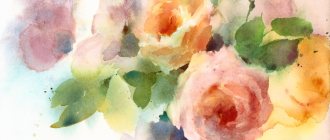• Continue to get acquainted with Gorodets painting, its color, and features.
• Be able to identify the main elements of a pattern.
Tasks:
• Educational: practice drawing Gorodets flowers - baths, roses, observing the sequence of stages of the image; in applying the resin using the tip of a brush.
• Developmental: Develop a sense of composition, the ability to beautifully arrange a pattern in a given shape. • Educational: develop artistic taste and cultivate love and interest in folk art.
Specifics of the technique
In old Gorodets, where this painting takes its name, the main sale of wooden household items painted in a special style created by the artisans of that time took place
Initially, painting was used to decorate spinning wheels. The fact is that the Gorodets spinning wheels themselves consisted of several parts; the bottom itself served to secure the hoop with the comb. They sat on the bottom while working, then the spinning wheel was dismantled and hung on the wall. Thus, the need arose to decorate the boards, turning them into pictures for a while. With their design solution, the Volga region craftsmen attracted many residents to purchase such a product, which gave rise to the development of Gorodets painting as a folk craft.
Frozen storylines were depicted on the bottoms. Everyday, idle or other events from the life of peasants and merchants. Ladies and gentlemen in magnificent attire walked at fairs, drank tea, sitting at a round table, the background was not detailed, only surrounded by columns and flower arrangements, the design could be divided into tiers and framed by simple lines.
Gorodets painting is characterized by black horses, cats, capercaillie birds, peacocks, as well as flower arrangements.
The painting was applied directly to the wooden surface using tempera paints on egg yolk. Sometimes red and yellow paints could be used for the background. The color scheme has rich as well as diluted shades of red, yellow, and black. In later works green and blue appear.
Schemes for working on Gorodets patterns
In drawing classes, simple plots are used to master the elements of painting. But each job must be done in a certain order.
"Bud"
Work on this variety of flowers is carried out in accordance with the instructions.
The color of the buds can be varied, but only within the color scheme of Gorodets painting
- We start with the underpainting. We take red paint with a wet brush, remove the excess and dip it in water again so that the color is washed out.
- Draw a circle - apply pressure with the brush, then draw a semicircle and lower the brush down.
- Next, we do the shading - we take concentrated red and draw half-arcs on the buds, draw dots. Don't forget to hold the brush strictly vertically.
- We use green paint to spice things up - green leaves.
This work can be spiced up, that is, elements can be added.
"Chamomile and Kupavka"
Instructions:
- First we work with daisies.
- We do the underpainting with pink paint (we blur the red paint).
- Using rich red we create a shade - strokes located along the diameter of the daisy. Don't forget to hold the brush perpendicularly downwards.
- Let's start reviving. Making the red core of the flower.
- To brighten it up, use white paint to dilute the shade - alternate black strokes with white ones, and also make dots in the middle.
- We create the underpainting of the kupavka - draw a circle.
- Shading is a drawing of the middle.
- Let's make a preparation - draw white veins-petals in the form of two semi-arcs with jumpers.
Children should learn to draw circles without a rough outline, straight away “cleanly”
"Rozan"
Now we will describe the instructions for working on the “rosan” variety:
- For the underpainting we make a red circle and two leaves on the left and right.
- Using white paint we draw semi-arcs in the upper third of the rose.
- We connect them with strokes.
- We make petals emanating from the lower semi-arc.
- We make vertical strokes in each petal.
- We draw vein lines on the leaves.
Sometimes the shading is done with the color of the bait









